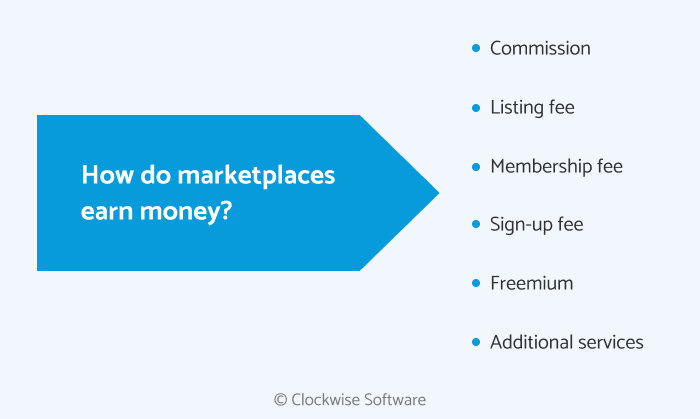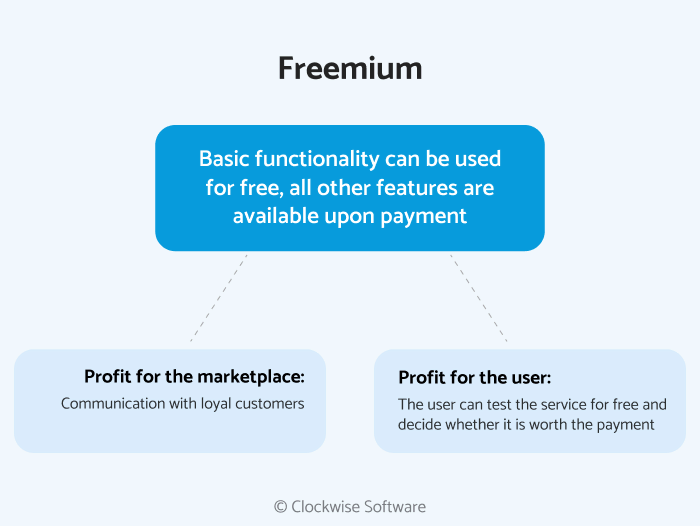What we do
Services
Experts in
If you have a marketplace idea on your mind, then you definitely want to understand the various marketplace business models. After all, creating your own product is not just fun. It should also bring you some revenue.
There are a handful of monetization options for marketplaces. However, your choice will depend on your specific case. But don’t be confused. We are a marketplace development company and we will help you choose the best match based on some inspiring examples from the world of big startups. Just find one that is closest to your industry and you’re done.
Surely, you already know what a marketplace business is (if not - this article is a must-read for you). Below, we’ll start talking about some more complex concepts.
An online marketplace business model is not like any other business. These are two key differences:

There are many ways to monetize your application. But only a few of them fit the online marketplace business model. The most common ones are:

Let’s take a closer look at how each of these models works.
A marketplace charges a percentage or a fixed price from each transaction as a commission.
The commission model is scalable. As your marketplace grows, more transactions occur and your income increases. In addition, your revenue depends on the value your product delivers. Therefore, your business development efforts are directly rewarded.
This model is the most attractive one for sellers and buyers since they have to pay you only after they have received value on your platform. This increases trust and customer loyalty. Sellers and buyers are more likely to register as they aren’t risking any upfront payments.
The main challenge is to decide who to charge: the seller or the buyer. Or both. The general rule is simple: decide which group you want to attract to your marketplace, and charge the other group.
The common practice is to charge the seller - as Etsy, eBay, Amazon, and a handful of other outstanding marketplaces do.
However, Blablacar charges buyers. Their motivation is clear: they need more drivers that cover more various routes, so they attract them with zero fees. The passengers, on the contrary, see clear value from using the platform and are ready to pay a small fee to keep enjoying all the benefits of Blablacar.
Deciding on the commission amount might be challenging as well. A high percentage could be less attractive to your users, a low one won’t cover your expenses. The first thing you should do is analyze your competitor marketplaces and business model. Look at how eBay makes money and compare it with the Etsy revenue model, the go through local and niche platforms. The gathered insights will help you decide on the commission for your marketplace. However, be ready to adjust it later.

The seller is charged a fixed fee for each listing posted.
Commissions don’t guarantee any income for the marketplace owner. In this case, your profit depends a lot on the quality of product and sales skills of your customers - something that is out of your control. Listing fees can help you secure a certain income.
Listing fees are usually a tiny amount (a few cents to a few bucks). This is also a fixed fee, which means that the seller can plan their budget in advance. Everything is transparent and there are no additional payments that may or may not apply.
Sellers are ready to pay upfront only if they see the clear value. The listing fee will work only if you have a large customer base to offer products. Getting access to thousands, or even millions of potential buyers for a small fee sounds like a good deal for the seller, doesn’t it?
You have to ensure that you provide clear value before charging any upfront payments.
eBay, for example, has a huge user base. The service offers 50 zero insertion fee listings per month. If the seller wants to sell more items, they have to buy a package of listings. And there is a high demand for paid listings. The reason is simple: eBay is well-known for having over 180 million active users worldwide. Paying for an opportunity to reach them seems reasonable for sellers.

The user is charged a one-time or recurring fee to enjoy all the benefits of the platform.
When charging a monthly subscription fee, you can count on a stable predictable income. This makes it much easier to plan the project budget.
Users have stable expenses, no matter how much they sell or buy.
A subscription model works well when the majority of marketplace members makes several transactions per pay period.
For example, clients of HomeExchange can choose between one-time payment and a yearly fee. If a client plans to spend more than 10 nights as a guest of HomeExchange members, a yearly subscription is a good deal for them.
Couchsurfing, on the contrary, charges a one-time payment for a user to get a verified account. This works well for frequent Couchsurfers. However, occasional users won’t see much advantage from the verification payment.
There is one more thing to consider. A subscription should give users access to some premium information or listings they won’t find on any other platform for free. This justifies the payment.

Freemium is a classic monetization model for all kind of apps. By adopting it, app companies grant users access to basic (limited) functionality for free. Advanced features are available after a one-time payment or upon subscription.
This model works similarly for marketplace services as well. There are a few options for reasonable freemium offers:
Users can first try your services for free and decide whether it’s worth to pay for it. They don’t have to spend money without any clear benefit.
Your users have tested the service and have clear expectations. These are already your loyal customers.
You have to ensure that your paid services offer enough added value.
Also, be ready for most of your clients to use your marketplace for free. It’s difficult to calculate the price for additional services that will help you fill your budget. You’ll have to experiment with pricing models and bundles.
The income of a marketplace with a freemium monetization model is usually unpredictable. You should always motivate users to buy additional services (think of special offers, bundles, etc), otherwise, your earnings may drop.
Each marketplace is different, and there is no ultimate receipt for implementing a freemium model. You have to invent additional services that fit your specific case. Etsy, for example, enables its premium sellers to design and print their own shipping labels. These are very helpful for sellers that want to promote their own brand.

Users post their listings in your marketplace for free. However, they can pay to promote these listings and get a higher chance to sell.
Users can start using the marketplace without any obligations. After their online business grows, they can invest in advertising to sell even more or they can keep using the service for free forever since there are no restrictions on the number of listings.
When users are ready to pay for ads, this is a clear sign that your marketplace has reached a success milestone. You can develop several promotion options to ensure that there is an offer for every type of user.
When there are just a few listings in each category, an interested client will watch them all before making the right choice. But when there are thousands of similar items for sale, the chances of a buyer scrolling down to a particular listing are much lower. Advertising is a good option for sellers to get noticed.
Sellers are ready to pay for promotion only when the competition is high. This means that you won’t earn much in the first years of your marketplace business if you count on promotions only.
Paid promotion shouldn’t be your primary monetization strategy. Focus on growing your user base first.
OLX Group is one of the marketplaces that has successfully implemented the paid promotion. In each country, where OLX operates, it is the major e-commerce platform, with millions of users. Huge competition in certain categories forces sellers to pay for their listing to be noticed. However, the fact that OLX shows the offer to thousands of interested buyers makes such an investment a good deal.

Now that you know the theory of how a marketplace business can earn money, it’s time to have a look at the practical implementation. We have analyzed the business models adopted by the most successful online marketplaces of our time.
A little spoiler first: none of them adhere to one monetization model. The key to their success lies in a smart combination of various approaches.
How does eBay make money? This question is tricky since the giant doesn’t earn from marketplace services alone.
Over 30% of eBay’s income is the revenue generated by PayPal. This payment service was acquired by eBay in 2002 and seems to pay back quite well!
Another 6% of revenue comes from creating online shop websites for brick and mortar stores.
But we know you came here to find out about eBay’s marketplace business model. And we’ll give you the details.
As mentioned, eBay allows its users to post 50 items for free every month. The price of the next listings depends on the category and varies between 5 and 30 cents.
Additionally, the seller is charged 10% of each transaction.
Users are also encouraged to pay for additional services. For example, they can make their listing more attractive by adding larger pictures for 35 cents.
As you can see, eBay has successfully combined freemium, listing fees, commissions and paid promotion services.
Now let’s take a look at Etsy's business model and revenue model.
The creative marketplace has adopted several revenue strategies. To answer the question of how Etsy makes money, we’ll analyze all their fees:
Etsy’s revenue model relies on multiple income channels. Some payments are required - you can’t sell on Etsy unless you pay a listing fee and a commission. Promotion fees and additional paid services are optional and target advanced sellers only.
Such a model enables Etsy to ensure a stable revenue stream.
If you want to find out more about this marketplace, don’t miss our article on how to create an online marketplace like Etsy.
The hospitality marketplace Airbnb has adopted a two-sided marketplace business model. This means that it charges both sellers and buyers. Let’s take a look at the fees:
Airbnb’s business model is quite simple and based on the commission model only. It doesn’t provide any additional services, advertising, etc.
The user only pays the commission fee in case of a successful transaction. So, there’s no risk for the buyer or the seller.
Airbnb is one of a few companies that charge their marketplace buyers. This is likely done to attract more service providers with truly low fees.
Now you know what marketplace business models are and what options are out there. You can use this information to decide which marketplace model (or models) fits your case best. Let’s summarize up all the information above.
First, you have to decide who you will charge. In most cases, the marketplace seller pays all the fees. However, you can charge the buyer as well, especially if you want to draw more sellers to your platform. Minimal (or no) fees look pretty attractive.

Don’t look for an ultimate business model for SaaS (software as a service) on-demand marketplaces or a B2B platform. There are dozens of ways to earn money with your marketplace. Find your unique business model.
We at Clockwise Software have vast experience with marketplace app development. And we’ll willingly share our knowledge for free! You can schedule a consultation with our manager and ask any questions related to the industry.
Also, subscribe to our monthly newsletter for more information about business, technology, and marketplaces, of course. You shouldn’t miss it!
